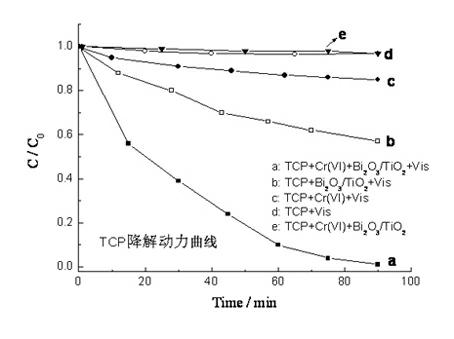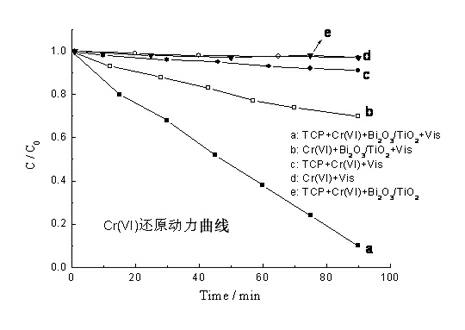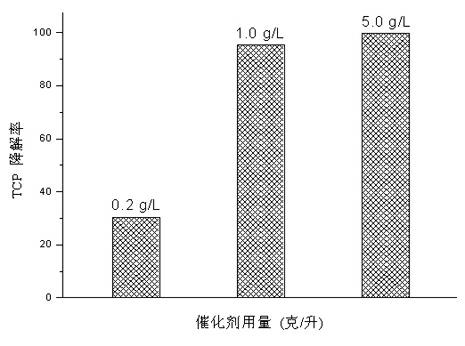Photochemical method for removing organic phenolic pollutants and hexavalent chromium in water body and preparation method of catalytic agent
A technology for hexavalent chromium and pollutants, applied in the direction of physical/chemical process catalysts, water pollutants, chemical instruments and methods, etc., to achieve the effect of wide application range, broad application prospects, and improved removal efficiency
- Summary
- Abstract
- Description
- Claims
- Application Information
AI Technical Summary
Problems solved by technology
Method used
Image
Examples
Embodiment 1
[0040] Preparation of mesoporous Bi 2 o 3 / TiO 2 Composite nano-visible photocatalyst:
[0041] Dissolve bismuth nitrate in nitric acid of a certain concentration, add a mixed solution of tetraisopropyl titanate and isopropanol drop by drop while stirring at room temperature, the molar ratio of bismuth nitrate to titanate is 3.0%, after the addition is completed Stirring was continued for 2 hours, followed by hydrothermal treatment for 5 hours, cooling to room temperature to remove the supernatant, and infrared drying for 2 hours to obtain light yellow mesoporous Bi 2 o 3 / TiO 2 Composite nano-visible light photocatalyst.
[0042] A glass reactor containing 50 ml of simulated composite polluted wastewater containing 60 mg / L TCP and 45 mg / L hexavalent chromium, mesoporous Bi 2 o 3 / TiO 2 Composite nano-visible light catalyst 50 mg (amount of 1.0 g / L composite polluted wastewater), adjust the pH value of the wastewater to 3.0 with nitric acid, the artificial light source...
Embodiment 2
[0044] The three glass reactors contained 50 ml of simulated composite polluted wastewater, which contained 45 mg / L of hexavalent chromium and TCP with a concentration of 60, 200, and 600 mg / L, respectively, and added mesoporous Bi 2 o 3 / TiO 2 Composite nano-visible light catalyst 50 mg (amount of 1.0 g / L composite polluted wastewater), adjust the pH value of wastewater to 3.0 with nitric acid, the artificial light source used is a 300W xenon lamp, equipped with a 420 nm cut-off filter, turn on the light source and irradiate with visible light for 90 minutes , so that the mesoporous Bi 2 o 3 / TiO 2 Composite nano-visible photocatalyst is excited by visible light to undergo charge separation, using TiO 2 The valence band holes or hydroxyl groups generated by oxidized water photocatalytically degrade TCP, while Bi 2 o 3 The conduction band electrons can reduce the coexisting hexavalent chromium to trivalent chromium with low toxicity. The reaction results are shown in Tab...
Embodiment 3
[0046] Each of the three glass reactors contained 50 ml of simulated composite polluted wastewater, which contained 60 mg / L of TCP and 20, 150, and 500 mg / L of hexavalent chromium, and respectively added mesoporous Bi 2 o 3 / TiO 2 Composite nano-visible light catalyst 50 mg (amount of 1.0 g / L composite polluted wastewater), adjust the pH value of wastewater to 3.0 with nitric acid, the artificial light source used is a 300W xenon lamp, equipped with a 420 nm cut-off filter, turn on the light source and irradiate with visible light for 90 minutes , so that the mesoporous Bi 2 o 3 / TiO 2 Composite nano-visible photocatalyst is excited by visible light to undergo charge separation, using TiO 2 The valence band holes or hydroxyl groups generated by oxidized water photocatalytically degrade TCP, while Bi 2 o 3 The conduction band electrons can reduce the coexisting hexavalent chromium to trivalent chromium with low toxicity. The reaction results are shown in Table 1, which sh...
PUM
 Login to View More
Login to View More Abstract
Description
Claims
Application Information
 Login to View More
Login to View More - R&D
- Intellectual Property
- Life Sciences
- Materials
- Tech Scout
- Unparalleled Data Quality
- Higher Quality Content
- 60% Fewer Hallucinations
Browse by: Latest US Patents, China's latest patents, Technical Efficacy Thesaurus, Application Domain, Technology Topic, Popular Technical Reports.
© 2025 PatSnap. All rights reserved.Legal|Privacy policy|Modern Slavery Act Transparency Statement|Sitemap|About US| Contact US: help@patsnap.com



